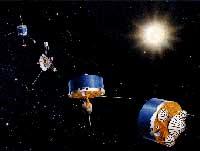NASA recovers one of its "lost children"
This is the first time they have known the Pioneer 10 since August last year, so NASA has been very happy. It seems that since last summer only received an incomprehensible transmission. Finally, instead of waiting to receive the Pioneer 10 signal, they decided to send him a signal. And so they did. The signal reached the spacecraft and its shipment was received in Madrid.

Pioneer 10 was sent out of the solar system on March 2, 1972. It now orbits about 13 billion kilometers of Earth, the first spacecraft to pass through the asteroid belt, and the first to obtain images near Jupiter. As he passed around Jupiter, he studied his magnetic exterior and discovered that this planet was mostly liquid.
After observing Jupiter, he explored the remote areas of the solar system and studied the energy particles of the Sun and the cosmic waves that penetrate our part of the Milky Way. In 1983, when it went beyond Pluto's orbit, it was the first man-made object to come out of the solar system. He completed his scientific research on 31 March 1997, when he was 10 billion kilometers away. The signal sent from there took 9 hours and 43 minutes to reach Earth.
Pioneer 10 is known for carrying a gold plaque with individual images of men and women and goodwill information on Earth. From its current location, the signal takes 21 hours and 45 minutes to reach Earth.
To learn more about the Pioneer 10 spacecraft click on this NASA page
Buletina
Bidali zure helbide elektronikoa eta jaso asteroko buletina zure sarrera-ontzian











